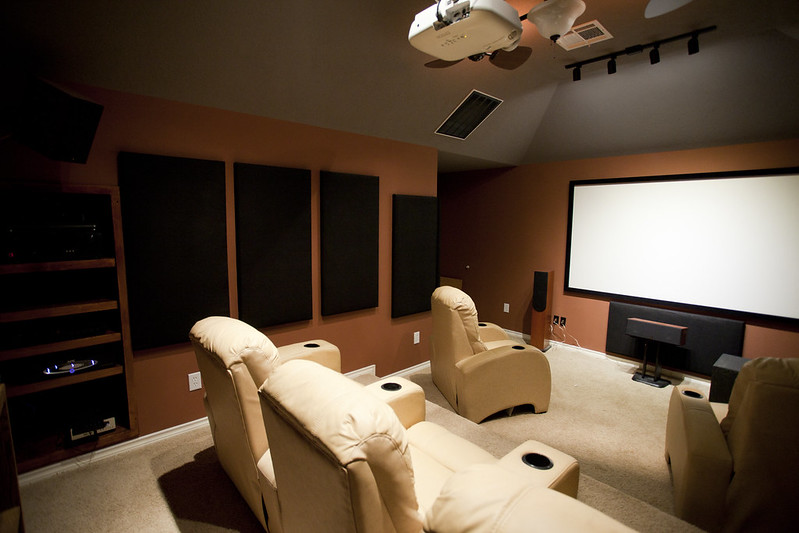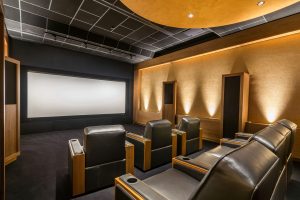Beneath the Screen: Crafting a Low-Ceiling Basement Home Theater
When creating soundproof spaces in our homes for music rooms or theaters, few areas offer as many natural benefits as the basement. Concrete walls and earth completely capture most sound waves produced. That means you won’t bother the neighbors with your booming bass, and equally important, you won’t have your movie night interrupted with unwanted noise. Unfortunately, the acoustics in basements don’t always measure up to the soundproofing ability. In order to get the most out of your new room, you’ve got to set it up right.
There is an art to creating a low ceiling basement home theater that both sounds great and offers complete isolation from the outside world. Low ceilings experience different issues than their extremely high counterparts. You won’t need as many acoustical materials as you’d need in a very large room, but you will need some thoughtfully placed panels and diffusers to make the room sound the way you want it to.
The problem with low ceilings
Many people would consider ten feet an ideal ceiling height for acoustics. It’s just enough room for waves to travel without excess buildup. Unfortunately, most basements provide eight feet or less of clearance. When we’re working with lower ceiling heights, we’ve got to take the physics of the smaller space into account when designing a home movie theatre floor plan.
Ceilings lower than ten feet tall tend to increase the occurrence of audio issues like slap echo and comb filtering. If you aren’t an audiophile, these terms may not mean much to you. What they add up to in simple terms is that the sound that falls flat. That’s not a desirable trait for a home theater or media room.
The largest parallel surfaces in low ceiling basement home theaters are extremely close to one another. That means our acoustical room design must be even more on point to deliver the immersive sound experience we expect.
Treating the floors and ceilings becomes a necessity in this scenario. And if you want the best sound possible, you won’t want to stop there. If you’re ready to turn your basement into a movie theater, here are some design ideas that will help you get great sound.
How to get the most out of your low ceiling basement home theater
Building a home theater room in the basement can turn that unused space into one of your favorite rooms in the house. For that reason, it’s important that you put the proper planning in place before finishing a basement with low ceilings. Following some simple principles, you can get wonderful acoustics and aesthetics out of your low ceiling basement home theater.
Maximize your ceiling height
If you’ve got a very low ceiling basement height, you’ll want to add every inch you can to help increase the area you’re working with. Depending on what type of ceiling you currently have, you may be able to get a little more height into the space. For instance, if you’ve got a drop ceiling suspended below your mechanical, electrical, and plumbing (MEP) systems, you can frame around the ductwork and install drywall on that frame as well as the overhead joists. This may net you an extra foot.
Choose a functional and appealing ceiling style
Height aside, the materials you choose for your ceiling will have a big impact on the sound in the room. Acoustical options can contribute to quality sound without looking like you’ve sacrificed style in the name of functionality.
One option is a T-grid suspended ceiling system with acoustical tiles. You can set the height anywhere you like, and the removable tiles make any overhead projects a breeze. Simply pop a tile out, complete your project, and drop it back in. There’s no cleanup or patchwork. That can be a lifesaver if you choose to run any overhead wires or cables down the road.
A coffered ceiling fitted with acoustical panels can be a wonderful solution if you’re after a more high end look, but still want to hang onto as much overhead space as possible. This type of ceiling delivers the look of a modern media room with acoustic properties that deliver great sound. Whatever you do, find a balance of form and function to get great sound out of your low ceiling basement home theater.
Utilize absorption on the ceiling
With a low ceiling height, the early reflections off the ceiling and floor will happen sooner and with more force than they would in a room with higher ceilings. Adding decent absorption overhead between the speakers and the viewing area will help eliminate problems caused by these early reflection points on home theater ceilings.
Also, since basement floors are overwhelmingly made of concrete, adding something soft there will help reduce issues created by reflections there. You aren’t working with a whole lot of height with a low ceiling basement home theater, so a simple solution of carpet and an underlayment will add a little absorption without adding much height.
Use acoustical panels on the walls
Your walls are another surface that can cause audio issues when watching movies in your new theater. Your basement home theater setup should reflect that with acoustical panels that offer absorption at key spots.
You’ve got early reflection points on the walls too. Sit in your normal seat, and have a friend slide a mirror along the wall until you see the speaker in the reflection. Do the same on the other side of the room and you’ve found two incredibly important acoustic panel locations. Add some more around the room, and your room will experience an immediate upgrade.
Don’t forget diffusion
As important as sound absorption is for your low ceiling basement renovation project, it won’t solve all issues. In fact, too much absorption will cause the room to sound dead. In addition to absorbing sound waves, you’ll want to scatter them as well. This is accomplished through the use of diffusers.
Sound diffusers present solid surfaces at different heights and angles so that sound waves won’t bounce directly off them and cause issues. Instead, the dispersed reflections off a diffuser bounce in all directions, creating a vibrant sound without producing too much echo or reverb. Adding them at the ends of the room will deliver great results.
Utilize Acoustical Curtains
A heavy, silky curtain adds a touch of class to any theater. It creates the illusion of a grand event, and eliminates unwanted glare. If you choose the right curtains, they can even help improve the sound of your low ceiling basement home theater. Their benefits are derived directly from the way they are constructed.
Acoustical curtains are dense enough to trap a substantial amount of sound waves. They are also thick enough to completely block out any light, meaning they can pull double duty to eliminate common problems posed by basement windows. Play around with some home theater curtain ideas and you’ll find something that suits the space perfectly.
Big screen TVs vs projectors
When we build home theaters, we often choose to go with projectors for maximum screen size. Projectors look great in dark rooms, and they can fill an entire wall with vibrant video images that rival the local multiplex. However, in rooms where space is at a premium, they aren’t always the best choice. If your low ceiling height forces you to place the projector in a location where people or objects will interfere with the full picture, you may be better off with a big screen TV.
The new generation of big screens are available in sizes that will likely fill the entire space you have allotted for the screen. You also have different technologies available to you. You can go with a QLED screen if you desire a brighter picture. This is a great choice if you get a lot of light coming in through the home theater entrance or windows. You can also go with an OLED screen. This is a great choice if you want deep, dark blacks. Take inventory of your space to help you decide which option will work best for your low ceiling basement home theater.
Stadium seating
If you’ve got enough room to raise your seating without obstructing the screen, stadium seating can be a wonderful way to increase basement seating capacity without causing obstructed views or craned necks. This allows everyone in the room to watch comfortably from ideal viewing angles.
Stadium seating utilizes slight increases in elevation from one row to the next. The seating level behind the first will raise viewers’ eyes above the heads of the row in front. If you add additional rows, each row will get successively higher. If you don’t have the room, a simple set of movie chairs for your basement theater will look great and provide ample comfort.
Work with professionals
While all these low basement ceiling ideas will help deliver the sound you’re after, they must be made of quality materials and placed correctly to deliver the biggest benefits. If you’re new to the world of acoustical design, working with professionals will ensure your low ceiling basement home theater meets your expectations. Our years of experience and knowledge of products will ensure you get the results you’re after without wasting time or money on the wrong DIY basement home theater solutions.


















Add comment
You must be logged in to post a comment.